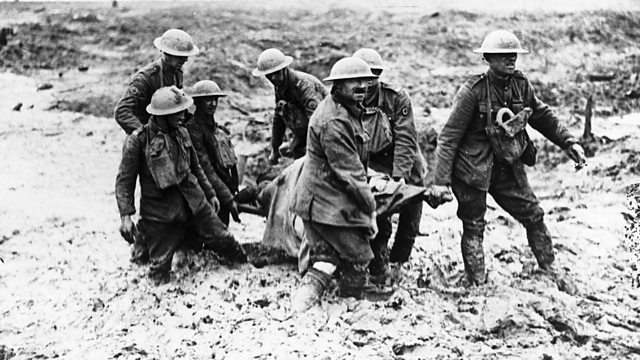How War and Conflict Have Helped to Improve Medical Treatments
From blood transfusions to facial reconstructive surgery β treating injuries caused by war and conflict have helped to drive medical innovations.
The personal cost of war for both military and civilians is high. But as well as the lives lost through conflict, there has also been a positive legacy from warfare β in pioneering of new treatments. From dealing with blood loss to extraordinary advances in facial reconstructive surgery, conflicts like World War I have driven technological innovation. This week sees the opening of a new exhibition called Wounded at Londonβs Science Museum. It coincides with the 100th anniversary of the Battle of Somme in Northern France. On 1st July 1916 alone, there were 58,000 British casualties.
The need for speedy and effective evacuation and treatment for the injured on the frontline was urgent. But the narrow trenches on the edges of the battlefields made it very difficult to carry the wounded to field hospitals. The deputy curator of the Wounded exhibition Vikki Hawkins explains how a special stretcher β which could be adjusted to turn round tight corners β was used in the muddy trenches. Paper tags were tied onto soldiers to record their injuries and whether medication had been given or a tourniquet applied to stem blood loss. Examples of these tags from both the German and Allied forces are on display at the museum.
Many of the fields of battle were covered in animal manure and infection was a risk to injured soldiers. Anti-tetanus serum was given and antiseptic used to help keep wounds clean. Gadgets such as the Carrel Dakin apparatus were used to deliver antiseptic solution directly and continuously into a wound β via tiny rubber tubes.
Blood loss from shrapnel and bullet wounds was an immediate challenge to medical staff on the frontline. Eddie Chaloner is a consultant vascular surgeon whoβs served in the Royal Army Medical Corp in Rwanda, Bosnia, and Kosovo.
He explains how blood transfusion was still in its early stages during the First World War. The ABO blood groups had only been discovered by Austrian physician, Karl Landsteiner in 1900 β and the Rh factor wasnβt identified until just before World War II. Direct transfusion β from the donorβs body into the recipient sitting next to them β could be carried out, but not on the large scale required by battlefield injuries. A significant step forward was taken when scientists worked out how to stop the blood from clotting β by using the chemical sodium citrate.
When the Germans first started to use poison gas as a weapon, British physiologist John Scott Haldane β famous for bold self-experimentation - went to the frontline to try and identify the gases used. Curator Vikki Hawkins explains how one exhibit, Haldaneβs Oxygen Apparatus, may have been a prototype to treat gassed soldiers. It was designed to allow four people to received oxygen at a time β at a pre-selected concentration. Haldane later invented the gas mask. A number of gases were used as weapons - chlorine gas on its own or mixed with phosgene, and later mustard gas caused severe blistering to the body. Doctors used paraffin to treat the blisters.
As well as the injuries inflicted by gas, many hundreds of thousands were shot and field hospitals tried to mend the gunshot wounds. But today some victims of gunshot wounds are far from the battlefield. In countries like Afghanistan, Pakistan, parts of India and Latin America, so-called βcelebratoryβ gunfire involves firing weapons up into the air in order to mark a positive event. Theyβre often considered to be a harmless show of strength or bravado, but Hugo Goodridge reports from the Lebanese capital Beirut, where a number of people have been killed or injured by guns fired in the city. It is illegal to discharge a gun in a public place in Lebanon and the police have used social media to try and change attitudes towards celebratory gunfire.
One exhibit - the Thomas splint β has a simple construction and is made of thick wire with a padded circle at the top. It was used in the First World War to immobilise a fracture of the femur or thigh bone when transporting patients. If this wasnβt done the broken bones could cause bleeding by grating together as the patient was moved β which often proved fatal. The surgeon Henry Gray looked at the impact of the Thomas splint at the battle of Arras where 1,009 fractures of the femur were recorded in just six weeks. He showed that the device reduced the mortality rate from fractures of the femur from 80% to just 16%. Although some of the materials used have changed, Eddie Chaloner says that the Thomas splint is still used today on military and civilian patients alike.
During the First World War mass casualties were sustained in difficult environments. In modern conflicts casualties generally occur in smaller numbers and helicopters can be used to rescue the injured. Modern paramedics save lives by using haemostatic dressings which promote clotting in wounds.
(Photo: Stretcher-bearers behind the British front line, 1917. Credit: Science Museum, SSPL)
Last on
Broadcasts
- Wed 29 Jun 2016 21:32GMTΒιΆΉΤΌΕΔ World Service except East and Southern Africa & News Internet
- Thu 30 Jun 2016 01:32GMTΒιΆΉΤΌΕΔ World Service Americas and the Caribbean
- Thu 30 Jun 2016 02:32GMTΒιΆΉΤΌΕΔ World Service Online, Europe and the Middle East & UK DAB/Freeview only
- Thu 30 Jun 2016 03:32GMTΒιΆΉΤΌΕΔ World Service East Asia & South Asia only
- Thu 30 Jun 2016 04:32GMTΒιΆΉΤΌΕΔ World Service Australasia
- Thu 30 Jun 2016 06:32GMTΒιΆΉΤΌΕΔ World Service Europe and the Middle East & East and Southern Africa only
- Thu 30 Jun 2016 14:32GMTΒιΆΉΤΌΕΔ World Service except News Internet
- Sun 3 Jul 2016 19:32GMTΒιΆΉΤΌΕΔ World Service East and Southern Africa
Podcast
-
![]()
Health Check
Health issues and medical breakthroughs from around the world.


